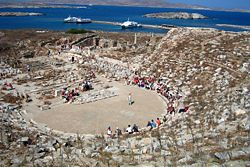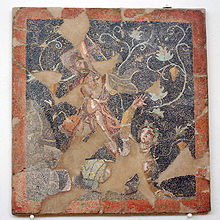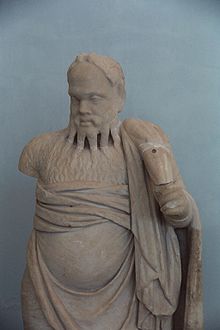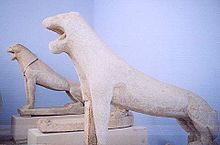- Archaeological Museum of Delos
-
Archaeological Museum of Delos 
Delos Theatre. The World Heritage site surrounding the museum which supplied the museum with its collectionEstablished 1904 Location Delos, Cyclades, South Aegean, Greece. Type Archaeological museum The Archaeological Museum of Delos (Greek: Αρχαιολογικό Μουσείο Δήλου) is a museum on the island of Delos, near Mykonos in the South Aegean, Greece. It is noted for its extensive collection of statues unearthed in the surrounding area of the ancient site, which has been declared a UNESCO World Heritage Site. Although the museum has a considerable collection, it does not contain all of the items found in Delos: a large quantity are on display in Athens at the National Archaeological Museum.
Contents
History
In 1872, the French School at Athens began excavating on Delos, in a project on a massive scale, which is still on-going today.[1][2]
As the collection accumulated, the museum was built on-site in 1904 by the Archaeological Society of Athens to accommodate the archaeological discoveries.[3] Its original five rooms went underwent expansion in 1931 and then again in 1972 to nine rooms.[4]
Displays
The museum's notable collection of funerary statues and grave stelae ranging from the 7th to the 1st century BC form the bulk of the collection. Its ancient pottery collection dates from the 25th to the 1st century BC, while the clay figurines, jewellery and mosaics conserved in the museum date back to the 2nd-1st centuries BC.[5] Six rooms contain the statues and reliefs found in Delos;,two rooms contain the pottery and another room contains items used in everyday life in ancient Greece.[4]
 Mosaic, depicting King Lycurgus of Thrace killing Ambrosia
Mosaic, depicting King Lycurgus of Thrace killing Ambrosia
Of major note is an ivory plaque which dates to 1400-1200 BC that depicts a Mycenaean soldier clad with a helmet made from wild boar teeth with defensive shield and spear.[3][6] It was discovered at Artemision along with other gold, ivory and bronze items.[3] The museum has a 5th-century marble statue of Boreas which portrays the infamous kidnapping of the Athenian princess Oreitheia and marble statues of Dioskourides and his wife Kleopatra, who lived on Delos island.[3] The statues, which were unearthed at their former residence, date from 138 BC, according to the inscription on the base, which indicates they were erected by Cleopatra in order to honour her husband, who dedicated two silver tripods to the temple of Apollo.[3][7]
The marble statue of Apollo after a Praxitelean model depicts the god inclining on a tree and striding on a bundle of Gallic shields and is believed to date back to the 2nd century BC. A bearded bronze mask of Dionysos that depicts the god wearing a crown and an ivy garland was discovered at the Market of the Competaliasts and is believed to date to the same period as the Apollo.[3]
The Delos Archaeological Museum also contains the torso of a kouros of the 6th century BC, and an inscribed triangular base of another kouros statue found in the Sanctuary of Apollo dated to the 7th century BC; it is decorated with the head of a ram on one corner and gorgon's heads on the other two. The inscription engraved on one side says: "Euthycartides the Naxian made me and dedicated me".[8]
There is a set of large lion statues which are originals; of those reproduced outside on the Delos site. There is a Corinthian alabastron, which is a small, perfumed oil container with an artistic depiction of Potnia Theron, the lady of the beasts and protectress of hunting, among two swans.[9] It was discovered in the Heraion along with similar Corinthian vases dating to the end of the 7th century BC. The Delos Archaeological Museum also has an archaic statue of a woman, found in the Sanctuary of Apollo dated to 580 BC.[10] The statue represents a young woman standing, dressed in a tight peplos decorated in front with an incised vertical double meander. There is also a valuable fresco taken from the exterior wall of a house in the Skardana Quarter, depicting Heracles, two boxers and a man playing a flute or trumpet. The inscription which says "Kalamodrya" is believed to refer to the prominent boxer of the 1st century BC.[11]
See also
- Delos -details of the heritage site
References
- ^ Bromiley, Geoffrey William (1979). International Standard Bible Encyclopedia: A-D. Wm. B. Eerdmans Publishing. pp. 256. ISBN 0802837859. http://books.google.co.uk/books?id=-J6rtnfjHQoC&pg=PA256&dq=Delos+1872+french+school#v=onepage&q=Delos%201872%20french%20school&f=false.
- ^ "The Archaeological Site of Delos". Hellenic Republic Ministry of Foreign Affairs. http://old.mfa.gr/english/greece/through_time/archaeology/ancient_sites/delos.html. Retrieved October 13, 2009.[dead link]
- ^ a b c d e f "Delos Archaeological Museum : Information about the Archaeological Museum on Delos". Greeka.com. http://www.greeka.com/cyclades/mykonos/mykonos-museums/arch-museum-delos.htm. Retrieved October 2, 2009.
- ^ a b "Archaeological Museum of Dios:History". Hellenic Ministry of Culture. http://www.culture.gr/h/1/eh152.jsp?obj_id=3262. Retrieved October 2, 2009.
- ^ "Archaeological Museum of Dios:Description". Hellenic Ministry of Culture. http://www.culture.gr/h/1/eh151.jsp?obj_id=3262. Retrieved October 2, 2009.
- ^ "Mykonos:Archaeological Museum - Ivory Plaque". Travel-to-Mykonos. http://www.travel-to-mykonos.com/page.php?page_id=40. Retrieved October 2, 2009.
- ^ "Mykonos:Archaeological Museum - Dioscourides and Cleopatra". Travel-to-Mykonos. http://www.travel-to-mykonos.com/page.php?page_id=43. Retrieved October 2, 2009.
- ^ "Mykonos:Archaeological Museum - Base of a Kouros statue". Travel-to-Mykonos. http://www.travel-to-mykonos.com/page.php?page_id=47. Retrieved October 2, 2009.
- ^ "Mykonos:Archaeological Museum - Corinthian alabastron". Travel-to-Mykonos. http://www.travel-to-mykonos.com/page.php?page_id=46. Retrieved October 2, 2009.
- ^ "Mykonos:Archaeological Museum - Statue of a young woman". Travel-to-Mykonos. http://www.travel-to-mykonos.com/page.php?page_id=48. Retrieved October 2, 2009.
- ^ "Mykonos:Archaeological Museum - Wall painting". Travel-to-Mykonos. http://www.travel-to-mykonos.com/page.php?page_id=49. Retrieved October 2, 2009.
External links
Categories:- Archaeological museums in Greece
- Delos
Wikimedia Foundation. 2010.


